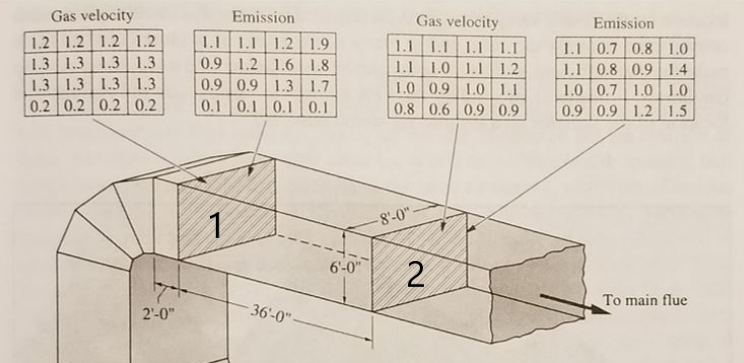stimate the total volumetric flow rate gas and the total mass emission rate of the particles in Fig 4.3.
stimate the total volumetric flow rate gas and the total mass emission rate of the particles in Fig 4.3.
Elements Of Electromagnetics
7th Edition
ISBN:9780190698614
Author:Sadiku, Matthew N. O.
Publisher:Sadiku, Matthew N. O.
ChapterMA: Math Assessment
Section: Chapter Questions
Problem 1.1MA
Related questions
Question
Subject: Air Pollution Formation and Control
Do not just copy and paster other online answers
Estimate the total volumetric flow rate gas and the total mass emission rate of the particles in Fig 4.3.
![Gas velocity
Emission
Gas velocity
Emission
1.2 1.2 1.2 1.2
1.3 1.3 1.3 1.3
1.3 1.3 1.3 1.3
0.2 0.2 0.2 0.2
1.1 1.1 1.2 1.9
0.9 1.2 1.6 1.8
0.9 0.9 1.3 1.7
0.1 0.1 0.1 0.1
1.1 1.1 1.1 1.1
1.1 1.0
1.0 0.9
1.1 0.7 0.8 1.0
1.1 0.8 0.9 1.4
1.0 0.7 1.0 1.0
0.9 0.9 1.2 1.5
1.1 1.2
1.0 1.1
0.8 0.6 0.9 0.9
8'-0"-
6'-0"
To main flue
2'-0"
36'-0"
Average gas velocity = 39 f/s
Average emission per unit area =
1.2 lb/ft2-hr
From No. 2
From No. 1
I.D. fan
I.D. fan
FIGURE 4.3
Measured velocities and particle mass flow rates (velocity concentration) in a complex duct. The values
shown are the ratio of the observed value to the average value for the whole duct. For example, near the bend,
where the velocity is shown as 1.2, the measured velocity was 1.2 - 39 f/s = 47 f/s = 14.3 m/s [2].](/v2/_next/image?url=https%3A%2F%2Fcontent.bartleby.com%2Fqna-images%2Fquestion%2F85ff80cd-34a8-4471-9907-d9de1b52412a%2F1e00fd99-3253-4156-b39f-239d1f97ad16%2Fkqlhx9_processed.jpeg&w=3840&q=75)
Transcribed Image Text:Gas velocity
Emission
Gas velocity
Emission
1.2 1.2 1.2 1.2
1.3 1.3 1.3 1.3
1.3 1.3 1.3 1.3
0.2 0.2 0.2 0.2
1.1 1.1 1.2 1.9
0.9 1.2 1.6 1.8
0.9 0.9 1.3 1.7
0.1 0.1 0.1 0.1
1.1 1.1 1.1 1.1
1.1 1.0
1.0 0.9
1.1 0.7 0.8 1.0
1.1 0.8 0.9 1.4
1.0 0.7 1.0 1.0
0.9 0.9 1.2 1.5
1.1 1.2
1.0 1.1
0.8 0.6 0.9 0.9
8'-0"-
6'-0"
To main flue
2'-0"
36'-0"
Average gas velocity = 39 f/s
Average emission per unit area =
1.2 lb/ft2-hr
From No. 2
From No. 1
I.D. fan
I.D. fan
FIGURE 4.3
Measured velocities and particle mass flow rates (velocity concentration) in a complex duct. The values
shown are the ratio of the observed value to the average value for the whole duct. For example, near the bend,
where the velocity is shown as 1.2, the measured velocity was 1.2 - 39 f/s = 47 f/s = 14.3 m/s [2].
Expert Solution
Step 1
Given data:
At section 1 and section 2, the measured velocities and particle flow rates are as follows:

Trending now
This is a popular solution!
Step by step
Solved in 3 steps with 3 images

Knowledge Booster
Learn more about
Need a deep-dive on the concept behind this application? Look no further. Learn more about this topic, mechanical-engineering and related others by exploring similar questions and additional content below.Recommended textbooks for you

Elements Of Electromagnetics
Mechanical Engineering
ISBN:
9780190698614
Author:
Sadiku, Matthew N. O.
Publisher:
Oxford University Press

Mechanics of Materials (10th Edition)
Mechanical Engineering
ISBN:
9780134319650
Author:
Russell C. Hibbeler
Publisher:
PEARSON

Thermodynamics: An Engineering Approach
Mechanical Engineering
ISBN:
9781259822674
Author:
Yunus A. Cengel Dr., Michael A. Boles
Publisher:
McGraw-Hill Education

Elements Of Electromagnetics
Mechanical Engineering
ISBN:
9780190698614
Author:
Sadiku, Matthew N. O.
Publisher:
Oxford University Press

Mechanics of Materials (10th Edition)
Mechanical Engineering
ISBN:
9780134319650
Author:
Russell C. Hibbeler
Publisher:
PEARSON

Thermodynamics: An Engineering Approach
Mechanical Engineering
ISBN:
9781259822674
Author:
Yunus A. Cengel Dr., Michael A. Boles
Publisher:
McGraw-Hill Education

Control Systems Engineering
Mechanical Engineering
ISBN:
9781118170519
Author:
Norman S. Nise
Publisher:
WILEY

Mechanics of Materials (MindTap Course List)
Mechanical Engineering
ISBN:
9781337093347
Author:
Barry J. Goodno, James M. Gere
Publisher:
Cengage Learning

Engineering Mechanics: Statics
Mechanical Engineering
ISBN:
9781118807330
Author:
James L. Meriam, L. G. Kraige, J. N. Bolton
Publisher:
WILEY